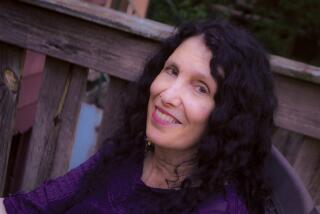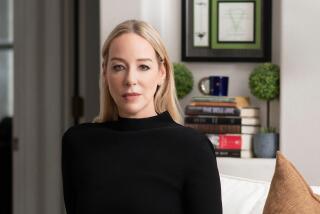Gayle Brandeis on her memoir ‘The Art of Misdiagnosis’
Gayle Brandeis’ mother was an entrepreneur, an artist and activist who had spearheaded letter-writing campaigns to remove guns from Walmart, had lobbied congress to change divorce law and had just become a grandmother again. But something was secretly wrong.
“After my mom hangs herself, I become Nancy Drew,” writes Gayle Brandeis in her memoir “The Art of Misdiagnosis: Surviving My Mother’s Suicide.”
Following increasingly alarming episodes of delusion, Brandeis’ mother went missing and ultimately took her own life. At the time of her death in 2009, she had been working on a documentary about her own artwork, which addressed a series of misdiagnoses she believed her family had received.
Brandeis weaves a journalistic exploration of the days surrounding her mother’s unraveling and suicide with a gripping family story of mental and physical illness, secrets and shame and the complex reckoning that she faced when writing this book. She reads Saturday at 7 p.m. at the Angels Flight literary salon at the Last Bookstore.
Brandeis writes with bravery and compassion; with the pace of a detective story, this memoir moves through pain and grief to hope, acceptance and love. Our conversation has been edited.
The title works on a number of levels. Can you unpack some of what “the art of misdiagnosis” refers to in the book?
I stole the title from my mom’s documentary. She was working on a documentary at the time of her death about her paintings and the various diseases that she thought ran through her family, these rare diseases which she felt are often misdiagnosed. I realized it worked on so many levels that my mom had never intended. There’s my own complicated journey with illness. There’s her mental illness, which was never diagnosed. There’s the way that we misdiagnosis each other by not fully understanding one another, the way we project ideas onto one another and can’t see each other clearly.
Why did you decide to weave transcriptions of your mom’s documentary into the narrative?
After I stole her title, it didn’t occur to me for a while to actually look at her film. Sometime later, I was invited to a women’s writing retreat in an art center that used to be a hospital; it’s supposed to be one of the most haunted sites in the country. There was something in me that thought I should pack her documentary. I packed up my son’s little portable DVD player and the DVD of her film and the first day there I decided to watch it.
I was so scared to see her on the screen — it was very, very emotional as the film began — but at some point I realized, “I need to transcribe this whole thing and weave it into the narrative, because this gives her a chance to speak for herself, to have her own voice.” Spending time with her film and spending time with her on the page allowed me to appreciate her ingenuity, creativity and her entrepreneurial spirit. She was a really remarkable woman in so many ways.
Parts of the book are framed as posthumous letters to your mother. In one, you call the book “my own misdiagnosis of your life.” What did you mean by that?
I first wrote that sentence as “my own diagnosis of your life” but I realized that whatever I’m going to discover about her, whatever conclusions I’m going to come to, may not be true. They may not be who she really was. I had to check myself; this story could be a misdiagnosis through my very subjective lens and my own experience. I tried with this project to see her in as clear and three dimensional a way as possible, but I understood, too, that she’s gone and I’ll never fully know her the way that I’d like to.
How much was destigmatizing the discussion around suicide and mental illness part of your drive to tell this story?
I was amazed after my mom’s death by how many people I knew who’d been touched by suicide but hadn’t talked to me about it because it was something their families said not to talk about or they had internalized some cultural message. In a bit of synchronicity, I was on my book tour on International Survivors of Suicide Loss Day and found a survivor event in Seattle. It was so moving: I’d had one-on-one conversations with other suicide loss survivors, but I had never been in a room full of them — of us.
Telling our stories is so important; we can help be life rafts for each other. After my mother’s death I was hungry for other stories of people who had been through something similar, so I just gobbled up as many books and essays as I could about suicide loss.
Joan Wickersham’s book “The Suicide Index” — its inventive structure — feels akin to this work.
That was the first book I read after my mom’s death. I loved what she did with form; it embodied how this kind of loss resists traditional narrative. I think that she, along with other writers, gave me permission to play with form. I was so grateful to find her work, as well as work by Linda Grey Sexton (Anne Sexton’s daughter); Nick Flynn’s work, which touches upon his mother’s suicide and Sara Manguso’s “The Guardians” about her friend’s suicide. It helped me feel less alone, like my story was part of this larger conversation.
You were sick as a teenager. Your mother believed that you had a rare disease, porphyria, that was misdiagnosed, when in reality you had begun to recover but secretly feigned and prolonged your illness. Did writing this feel confessional?
Yes. It was the most embarrassing, shameful secret that I carried for the longest time and in some ways it was still scary to admit, because I think about how many people do struggle with misdiagnosis and go through years of being told that they’re faking it when they’re not. But at the same time, writing this really helped me understand how it was this kind of contract that my mom and I had made together: being the sick girl and the mother of the sick girl had become central to our identity.
When were you ready to write this memoir?
I thought that it was something that I would just plunge into right away, because she had asked me not to write about her while she was alive, and there was so much I had wanted to write about her delusions and that I had wanted to explore. After she died, I thought, well, maybe now I can finally start to unpack all of this, but it was too fresh. I was in a state of shock and grief, plus I had a new baby. But I took notes. Somehow I had the presence of mind as this was all happening — as my mom went missing and right after her death — to jot down a few details that I didn’t want to forget. I started writing more in earnest when my son was about 17 months old.
Did writing this book change you?
It’s changed me so much I almost don’t recognize the person I was before I wrote it. I’m freer now, because I’ve faced myself and I’ve faced her in a way that feels satisfying, even though there will always be unanswered questions. I spent so much of my life trying to be the good girl, and I hid so much. The process of writing this book forced me to be honest with myself, and it’s easier now to be honest in the world. I’m not hiding the way I used to.
Did you have concerns about how your family would receive the book?
I tried not to think of those concerns as I was writing, because I knew that would freeze me. I told myself that no one was ever going to read it. But once I had a draft done, I did have concerns. It was very hard for my sister. We had some really tough conversations where — and I’m so glad she was able to tell me how she felt and that we were able to work through it — she shared that my writing the book almost felt like an act of violence against her, because I was choosing to reveal things that she was not choosing to reveal. We both did a lot of work around that and she ultimately gave me her full blessing. She even came out to a reading last week. I had a reading at Vroman’s in Pasadena on the 8th anniversary of my mom’s death, not far from the place of her death. It was very intense, and it meant so much to me to have my sister there. It was just a coincidence that my publisher set up the reading on that anniversary so close to the place.
That’s an astounding coincidence, but there were other instances of incredible narrative symmetry in the book. Gold reappeared consistently. (The Gold Line and a complex called the Golden Oaks are central to the narrative.) Was it ever a shock to discover so many coincidences?
It was a shock. These things kept revealing themselves, and at times I thought, ‘Is this even real?’ In fact, on the anniversary of my mom’s death my husband and son and I were driving on the 14 from Lake Tahoe to the reading in Pasadena, and suddenly I saw a sign off the side of the road for the Oak of the Golden Dream. This is the day of mom’s death — I was thinking so much about The Golden Oaks where she had died — and suddenly we see this sign. It just blew my mind a little bit. I asked my husband to turn around because I felt like had to see it. I didn’t know this, even though I had lived in California for so many years, but that oak is where the gold rush started. I was feeling this anticipation and nervousness about the reading and somehow finding this tree helped me relax. It felt like some sort of, I don’t know, sign, or at least sign post, that I was on the right path.
More to Read
Sign up for our Book Club newsletter
Get the latest news, events and more from the Los Angeles Times Book Club, and help us get L.A. reading and talking.
You may occasionally receive promotional content from the Los Angeles Times.







